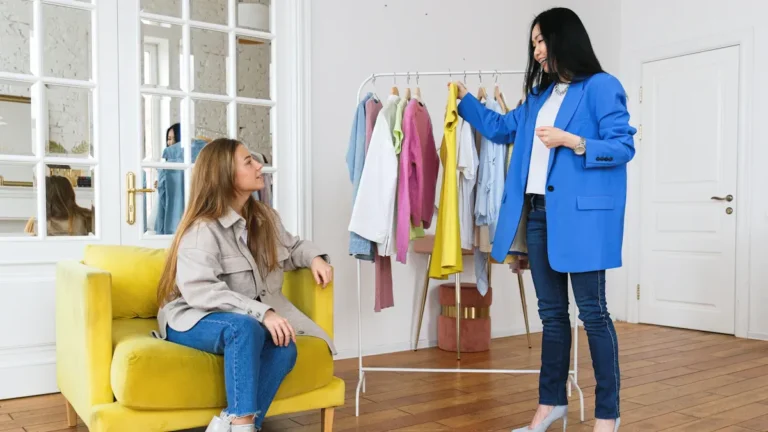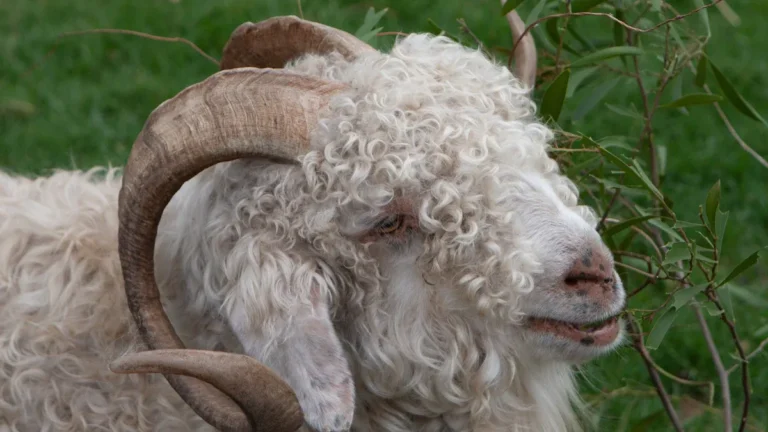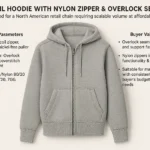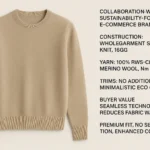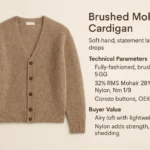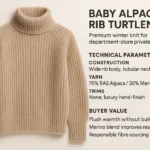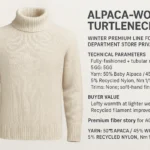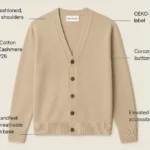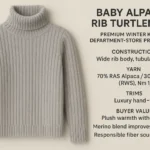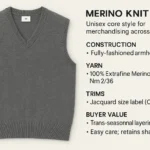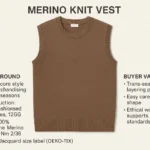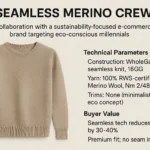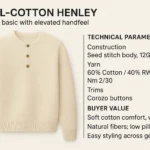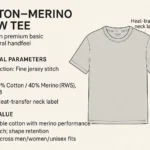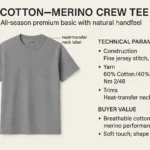
You can find many patterns in knitting, including Jacquard vs Fair Isle vs Intarsia Knitting. Jacquard knitting uses repeating patterns with many colors, while Fair Isle patterns change colors in every row. Intarsia patterns create neat blocks for single designs. You pick a technique based on what your project needs. The right choice helps you make patterns with fewer errors. Both hand and machine knitting allow you to change how your project looks and feels. The table below shows when to use each technique and what you can expect from your patterns:
Technique | When to Use | Characteristics |
|---|---|---|
Intarsia | Single designs, need for lightness or stretchiness | Neat blocks, no loose yarn, thin and stretchy fabric |
Jacquard | Patterns with many colors, mostly in the round | Repeating patterns, warm and thick fabric |
Jacquard vs Fair Isle vs Intarsia Knitting gives you choices for every project.
Key Takeaways
Pick the knitting technique that fits your project. Intarsia works well for big, bold designs. Jacquard and Fair Isle are good for repeating patterns.
Watch your yarn floats as you knit. Fair Isle needs short floats to look tidy. Jacquard can have longer floats for harder designs.
Practice changing colors so you do not make mistakes. Twist the yarns when you change colors in Intarsia. This stops holes and keeps your fabric flat.
Try easy patterns first if you are new. Fair Isle is simpler because you use two colors in each row. This helps you learn how to control tension and floats.
Key Differences
Overview
There are big differences between Jacquard, Fair Isle, and Intarsia knitting. Each one makes its own kind of pattern and fabric. Jacquard and Fair Isle both use two threads in each row. But Fair Isle only lets you use two colors in a row. It also keeps the floats short. Jacquard lets you use more colors in one row. The floats are longer, so the fabric is thicker. Intarsia is different because you use a new yarn for each color spot. You do not carry yarn across the back. This keeps the fabric light and stretchy.
Here is a quick comparison:
Technique | Color Management | Fabric Structure | Best For Patterns |
|---|---|---|---|
Intarsia | Each color zone is independent, no yarn transport | Disjoint columns of color | Large areas, complex patterns |
Jacquard (Fair Isle) | Two active threads, inactive carried on back | Thicker fabric with floats | Colorful, repeating patterns, geometric designs |
You can remember these things:
Intarsia lets you make big and bold designs.
Jacquard and Fair Isle are good for repeating shapes and patterns.
Fair Isle keeps floats short, so it looks neat.
Why It Matters
Picking the right knitting style helps you match your project to your skills. If you want a sweater with big color blocks, Intarsia is a good pick. Fair Isle is great for classic two-color patterns. Jacquard lets you use many colors and hard designs. But you have to handle longer floats.
Tip: Fair Isle’s short floats make the fabric light and neat. Jacquard’s long floats make it warmer and thicker.
When you know these differences, you can avoid mistakes. You can also pick the best way for your pattern. You will have more choices for new projects. Learning more styles means you can try new looks and textures in your knitting.
Jacquard Knitting
How It Works
Jacquard knitting lets you create colorful patterns by using more than two yarns in each row. You work with many yarns and change colors often. If you use a machine, you set up the machine, prepare the yarns, and check the memo window for color changes. You leave the carriages on the right side when you take breaks. Always make color changes at the left side through the color changer. You should knit swatches to find the best yarn tension. When you knit by hand, you start with a simple two-color pattern until you feel comfortable. You manage color changes and keep the tension even. You use the jacquard stitch to carry yarns across the back of the fabric. You must control the floats so they do not get too long or loose.
Tip: The Ladder Back Jacquard method helps you manage long floats. You add knit stitches in the middle of floats. This makes the fabric stretchy and stops snags.
Features
Jacquard knitting stands out for its pattern flexibility and fabric weight. You can make intricate designs without extra printing or embroidery. The jacquard stitch lets you use many colors in one piece. The fabric feels medium-weight and keeps you warm. It stays durable and holds its shape over time.
Feature | Description |
|---|---|
Pattern Flexibility | Integrates multiple colors into a single piece, allowing for complex designs. |
Fabric Weight | Creates a denser and warmer fabric, ideal for winter garments. |
Pros and Cons
Jacquard gives you many design choices. You can make beautiful and unique patterns. The jacquard stitch makes the fabric look and feel special. You find it easy to care for and comfortable to wear. However, jacquard fabrics can fade and lose elasticity. You should not wash them in strong sunlight. Machines for jacquard knitting cost more and need careful maintenance. Pattern changes take time.
Advantages of Jacquard Mechanism | Disadvantages of Jacquard Mechanism |
|---|---|
Tremendous design possibilities | Machines and harnesses are costly to install and maintain. |
Simpler in principle than dobbies | Jacquard fabrics are much more costly to produce. |
Novel style and beautiful appearance | Jacquard machines can produce faults in the fabric. |
Easy to care for and comfortable | Pattern change is time consuming. |
Best Uses
You can use jacquard knitting for sweaters, scarves, cushion covers, and throws. The jacquard stitch works well for jackets, accessories, zip-up blousons, and coats. You often see eye-catching sweaters and home textiles made with this technique.
Sweaters
Scarves
Cushion covers
Throws
Jackets
Accessories
Zip-up blousons
Coats
Fair Isle

How It Works
You use fair isle knitting to create colorful patterns with two yarns in each row. You hold both yarns at the same time and switch between them as you knit. The fair isle stitch lets you work a few stitches in one color, then change to the next color for the next set of stitches. You always keep both yarns attached. When you are not using a color, you carry it across the back of your work. This creates a float. You must avoid pulling the floats too tight. Spread out your stitches on the right needle when you change colors. This keeps your fabric flat and smooth. To stop yarn from tangling, pick up the first color over the second and the second color from under the first. In traditional fair isle, you often use a light or dark background with a contrasting motif color. Sometimes, you add a small amount of a bright color for extra detail.
Features
Fair isle knitting stands out because you use two active threads per row. The fair isle stitch creates multi-colored repeating patterns. You often knit in the round, which makes the fabric warm and dense. The patterns usually show geometric motifs or small repeating shapes. The fair isle stitch gives your work a neat and tidy look.
Technique | Unique Features |
|---|---|
Fair Isle | Uses two active threads per row, creates multi-colored repeating patterns, suitable for knitting in the round, results in warm and dense fabric. |
Pros and Cons
You get excellent stitch definition with fair isle. The fair isle stitch gives your fabric natural elasticity and helps keep your tension even. Wool blends stay warm and hold their shape. You need to watch your floats. If you do not manage them well, you may see puckering or loose threads. Beginners may notice uneven colorwork. Long floats need extra care and can show on the back.
Advantages | Disadvantages |
|---|---|
Excellent stitch definition | Tighter tension and thicker fabric |
Natural elasticity keeps tension even | Beginners may see uneven colorwork |
Wool blends stay warm and hold shape | Long floats need extra care and can show |
Tip: Good float management helps your fair isle stitch look neat and last longer. Poor float control can cause puckering or snags.
Best Uses
You can use fair isle knitting for many projects. The fair isle stitch works well for geometric motifs, peerie patterns, and oxo designs. You often see it in sweaters, cardigans, hats, mittens, gloves, scarves, cushions, blankets, and Christmas stockings.
Sweaters
Cardigans
Hats
Mittens
Gloves
Scarves
Cushions
Blankets
Christmas stockings
Intarsia Knitting

How It Works
Intarsia lets you create bold color blocks and pictures in your projects. You use a separate yarn for each color area. You do not carry yarn behind your work, so you avoid floats. This method works for both hand and machine knitting. When you change colors, you twist the yarns together to prevent holes. Here is a simple way to work intarsia:
Knit with your main color until you reach the spot for a new color.
Drop the main color and pick up the new color from behind.
Twist the two yarns together at the back to lock them in place.
Knit with the new color until the next change.
Repeat these steps for each color area.
Tip: Always twist the yarns at each color change. This keeps your fabric strong and stops gaps from forming.
Features
Intarsia creates a fabric that feels light and smooth. You use separate yarn spools for each color, which keeps your design clean and neat. You do not have floats, so your project will not feel bulky or heavy. This makes intarsia perfect for sweaters and blankets with large color areas.
No floats on the back
Clean color changes
Pros and Cons
Pros | Cons |
|---|---|
Can be tricky to master on machines | |
Allows for mid-row color changes | Needs careful yarn placement and tension |
Offers endless creative possibilities | Complex color changes can be confusing |
Best Uses
You can use intarsia for many creative projects. This technique works well for items with pictures, logos, or large blocks of color. You can make gifts that show off favorite cartoon characters or sports teams. Beginners should start with simple patterns before trying more complex designs.
Personalized sweaters and scarves
Blankets with images or logos
One-of-a-kind gifts
Projects with large, solid-color blocks
Note: Intarsia helps you create unique pieces that reflect your style and interests.
Jacquard vs Fair Isle vs Intarsia Knitting
Color and Float Management
When you compare jacquard vs fair isle vs intarsia knitting, you notice big differences in how you handle color and floats. Jacquard and fair isle both use floats, but you manage them in different ways. In fair isle, you carry unused yarn across the back of your work. These floats must stay loose so your fabric does not pucker. You usually work with two colors per row, which helps you keep the floats short and neat. This method gives you clean color changes and a tidy back.
Jacquard lets you use more colors in each row. You often see longer floats, which can make the fabric thicker and warmer. You need to watch your tension and keep the floats from getting too tight or too loose. If you want to avoid long floats, you can use special techniques like ladder back jacquard. This helps you make multi-colored designs without snags.
Intarsia works differently. You do not carry yarn across the back. Instead, you use a separate yarn for each color area. You twist the yarns together at each color change. This method lets you place colors anywhere in your pattern. You can create large blocks or intricate designs without floats. The back of your work stays smooth and light.
Here is a table to help you see the differences:
Technique | Color Management | Float Management |
|---|---|---|
Fair Isle | Unused colors float along the back of the fabric, creating clean color changes. | Floats should be slightly looser than regular stitches to prevent puckering. |
Intarsia | Involves fastening off and picking up colors as needed, suitable for larger areas. | Allows for intricate color placement without carrying multiple colors across work. |
Jacquard | Uses multiple yarns for complex designs and color combinations. | Requires careful float control, especially with long floats in multi-colored designs. |
Tip: If you want to use many colors or create complex designs, jacquard gives you the most flexibility. For neat color changes and short floats, fair isle is a strong choice. If you want no floats and smooth fabric, intarsia works best.
Pattern Complexity
Jacquard vs fair isle vs intarsia knitting also differ in the types of patterns and designs you can create. Jacquard stands out for its ability to handle complex designs and color combinations. You can knit geometric shapes, detailed motifs, or even pictures. The technique supports multi-colored designs and lets you use many shades in one row.
Fair isle focuses on repeating patterns and traditional motifs. You usually work with two colors per row. This method is perfect for classic sweaters and accessories with geometric shapes. The patterns look neat and balanced, but you have less freedom to use more than two colors at once.
Intarsia lets you create large blocks of color and bold images. You can knit pictures, logos, or any design with clear color areas. This method is great for complex designs that need separate color zones. You do not need to worry about floats, so your fabric stays light and stretchy.
Jacquard: Best for complex designs, geometric patterns, and multi-colored designs.
Fair Isle: Ideal for repeating patterns and traditional motifs with two colors per row.
Intarsia: Perfect for large color blocks, pictures, and intricate designs with no floats.
Note: If you want to knit a sweater with a detailed scene or logo, intarsia is your best option. For classic patterns with two colors, fair isle is easier to manage. Jacquard lets you explore the most complex designs and color combinations.
Hand vs Machine
You can use jacquard vs fair isle vs intarsia knitting by hand or with a machine. Each method has its own strengths and challenges.
Fair isle works well by hand. You hold two yarns and switch between them as you knit. Machines can also knit fair isle. They keep the tension even and make it easier to handle floats. You still use two colors per row, but machines help you avoid tight stitches.
Jacquard can be done by hand or machine. By hand, you manage many yarns and control the floats. Machines can knit double-sided color patterns and handle complex designs. You may face limits on the number of colors per row, but machines make it easier to keep your fabric neat.
Intarsia needs you to place each yarn by hand for every color block. This takes time and care. Machines can knit intarsia with special settings. They help you manage the yarns and keep the color changes smooth. You do not have floats, so the back stays clean.
Here is a quick list to compare:
Fair Isle: Hand knitting uses two colors per row. Machines automate the process and fix tension issues.
Jacquard: Hand knitting allows for creative float control. Machines handle complex designs but may limit color use.
Intarsia: Hand knitting is labor-intensive. Machines can speed up the process with special settings.
Callout: If you want to try complex designs or use many colors, jacquard on a machine can save you time. For simple patterns or personal projects, hand knitting gives you more control.
When you choose between jacquard vs fair isle vs intarsia knitting, think about your project, your skill level, and whether you want to knit by hand or use a machine. Each technique offers unique ways to manage color, floats, and pattern complexity. You can create beautiful, multi-colored designs with the right method.
Choosing a Knitting Technique
Project Match
You want your knitting technique to fit your project. Each method works best for certain designs and fabric needs. If you plan a multi-color project with repeating shapes, Jacquard or Fair Isle will give you warmth and dense fabric. Intarsia works well for projects with isolated motifs or large color blocks. You get clean edges and a stretchy feel. The table below helps you decide which technique matches your project:
Technique | When to Use | Characteristics |
|---|---|---|
Intarsia | Isolated central motifs, need for lightness, well-defined color areas | Clean blocks, thin and stretchy fabric |
Jacquard/Fair Isle | Multi-colored repeating patterns, mainly in the round, warmth desired | Repeated patterns, warm and dense fabric |
Tip: For a multi-color project with bold images, choose Intarsia. For a project with geometric pattern repeats, Jacquard or Fair Isle will work best.
Yarn and Skill
Your yarn choice and skill level affect your results. Thick yarns make patterns stand out, but thin yarns show details better. Beginners often start with Fair Isle because it uses only two colors per row. You learn to manage floats and tension. Intarsia needs careful color changes and yarn twisting. You must keep yarns separate to avoid tangling. Jacquard lets you use many colors, but you need practice to control long floats and keep the fabric smooth. If you want to try a multi-color project, start with simple patterns and build your skills.
Choose yarn that matches your pattern and technique.
Practice color changes before starting a big project.
Use smaller needles for tighter fabric and better joins.
Common Mistakes
Many knitters make mistakes when working with these techniques. You can avoid problems by watching for these issues:
Keeping bobbins too close to your work causes tangling and wastes time.
Failing to track progress on charts leads to lost stitches and hard corrections.
Using oversized needles creates fabric that is too transparent and shows joins poorly.
Mixing Intarsia and Fair Isle in one project makes the fabric look inconsistent.
Not maintaining even tension leads to uneven stitches and poor fabric quality.
Pulling floats too tight causes puckering and an unattractive finish.
Inconsistent color switching results in tangled yarn and uneven appearance.
Failing to follow the chart correctly causes mistakes in the pattern.
Note: Always check your chart and keep your tension even. You will get a better finish and enjoy your knitting more.
You now know the main differences between Jacquard, Fair Isle, and Intarsia knitting. Jacquard creates complex patterns with floats. Fair Isle uses two colors per row and short floats. Intarsia forms bold color blocks with no floats. To choose the best method, try these tips:
Do not fear complex textures—they may be easier than they look.
Practice new techniques often, like learning dance steps.
Always read your pattern and learn the abbreviations.
Pick yarn that shows off your design and is easy to find. Try new patterns to build your skills.
Technique | Description | Key Features |
|---|---|---|
Intarsia | Uses blocks of color without stranding yarn across rows. | No floats, bold color blocks. |
Fair Isle | Strands yarn across the row, creating floats. | Motifs, short floats. |
Jacquard | Allows for complex patterns with longer floats. | Intricate designs, many colors. |
Explore these techniques and enjoy creating your own unique projects!
FAQ
What is the main difference between Fair Isle and Jacquard knitting?
Fair Isle uses two colors per row and keeps floats short. Jacquard lets you use more colors in each row and creates longer floats. You get thicker fabric with Jacquard.
Can you mix Intarsia with Fair Isle in one project?
You can mix both techniques, but your fabric may look uneven. Try to keep each section clear. Practice on a small swatch before starting a big project.
Which technique is best for beginners?
Fair Isle is the easiest for most beginners.
You only use two colors per row.
You learn to manage floats and tension.
How do I stop holes from forming in Intarsia knitting?
Always twist the yarns together at each color change. This locks the stitches and prevents gaps. Pull the yarns snug, but not too tight.
What projects work best for each technique?
Technique | Best Projects |
|---|---|
Fair Isle | Hats, mittens, sweaters |
Jacquard | Blankets, coats, cushions |
Intarsia | Picture sweaters, logo items |






